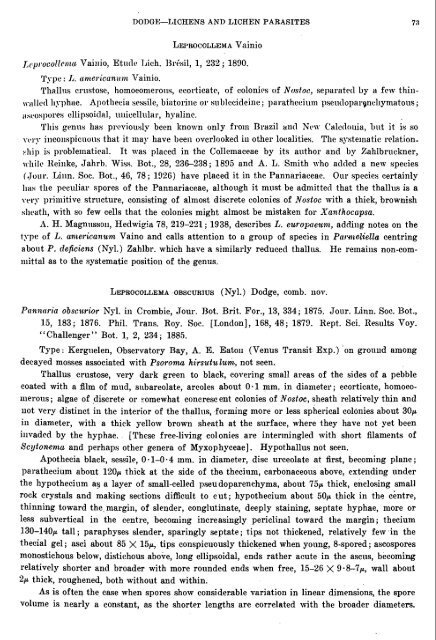You also want an ePaper? Increase the reach of your titles
YUMPU automatically turns print PDFs into web optimized ePapers that Google loves.
DODGE-LICI-IENS <strong>AND</strong> <strong>LICHEN</strong> <strong>PARASITES</strong><br />
LEI~~COLLEMA Vainio<br />
I;c.pl~ocolle~~lci Vail~io, Ett~dc Lich. BrCsil, 1, 232 ; 1890.<br />
Type : 1,. cirriericc~n~irrz Vainio.<br />
Tl~allns crustose, homoeomeroas, ecorticate, of colonics of Nostoc, separated by a fcm thin-<br />
\\illled I~yphcle. Apothecia sessile, biatoriilc or sublccideinc ; pal.atheeium pseudopalpicl~ymatous ;<br />
ilhc.osl,ores cllipsoiclal, unicellular, hyalinc.<br />
This genus has prc\~iouslp been known only froin Brazil and Nva Caledouia, bttt it is so<br />
~~1.y iilcollspiciloils that it may have been overlooked i11 other localities. The systematic relation-<br />
:liil, is problematical. It \\.as placed in thc Collemaceae by its author and by Zahlbruckner,<br />
\\.llilc lieinke, Jahrh. Wiss. Bot., 28, 236-238; 1895 and A. L. Smith who added a new species<br />
(Jour. Linn. Soc. Bot., 46, 78; 1926) have placed it in the Pannariaceae. Our species certainly<br />
lliis the pcculiar spores of the Pannariaceae, although it must be admitted that the thallus is a<br />
~ery priinitive structure, consisting of almost discrete colonies of Nostoc with a thick, brownish<br />
slleath, with so few cells that the colonies might almost be mistaken for Xanthocapsa.<br />
A. H. Magnussoii, Hedwigia 78, 219-221 ; 1938, describes L. europueztnt, adding notes on the<br />
type of L. an~ericanum Vaino and calls attention to a group of species in Par~nteliella centring<br />
about P. deficiens (Nyl.) Zahlbr. which have a similarly reduced thallns. He reinailis non-cominitttll<br />
as to the systematic position of the genus.<br />
LEPROCOLLEMA OBSCURIUS (Nyl.) Dodge, comb. 1101~.<br />
Parntcrria obscltrior Nyl. i11 Crombie, Jour. not. Brit. For., 13, 334; 1875. Jour. Linn. Soc. Bot.,<br />
15, 183; 1876. Phil. Trans. Roy. Soc. [London], 168, 48; 1879. Hept. Sci. Results Voy.<br />
"Challenger" Bot. 1, 2, 234 ; 1885.<br />
Type: Kerguelen, Observatory Ray, A. E. Eaton (Venus Transit Exp.) on ground among<br />
decayed mosses associated with Psoroma hirs~tulum~, not seen.<br />
Thallus crustose, very dark green to black, covering small areas of the sides of a pebble<br />
coated with a film of mud, snbareolate, areoles about 0.1 mm. in diameter; ecorticate, homoeomerous<br />
; algae of discrete or ?ornewhat concrescent colonies of Nostoc, sheath relatively thin and<br />
not very distinct in the interior of the thallus, forming more or less spherical colonies about 30p<br />
in diameter, with a thick yellow brown sheath at the surface, where they have not yet been<br />
illvaded by the hyphae. [These free-living colonies are interiningled with short filaments of<br />
Scytonema and perhaps other genera of Myxophyceae]. Hypothallus not seen.<br />
Apothecia black, sessile, 0.1-0.4 mm. in diameter, disc urceolate at first, becoming plane;<br />
parathecium about 120p thick at the side of the thecium, carbonaceous above: extending under<br />
the hypothecium as a layer of small-celled pseudoparenchyma, about 75p thick, enclosing small<br />
rock crystals and making sections difficult to cut; hypothecium about 50p thick in the ckntre,<br />
thinning toward the margin, of slender, conglutinate, deeply staining, septate hyphae, more or<br />
less subvertical in the centre, becoming increasingly periclinal toward the margin; thecium<br />
130-140p tall; paraphyses slender, sparingly septate; tips not thickened, relatively few in the<br />
thecia1 gel ; asci about 85 X 15p, tips conspicuously thickened when young, 8-spored ; ascospores<br />
monostichous below, distichous above, long ellipsoidal, ends rather acute in the ascus, becoming<br />
relatively shorter and broader with more rounded ends when free, 15-26 X 9.8-7p, wall about<br />
2p thick, roughened, both without and within.<br />
As is often the case when spores show considerable variation in linear dimensions, the spore<br />
volume is nearly a constant, as the shorter lengths are correlated with the broader diameters.

















